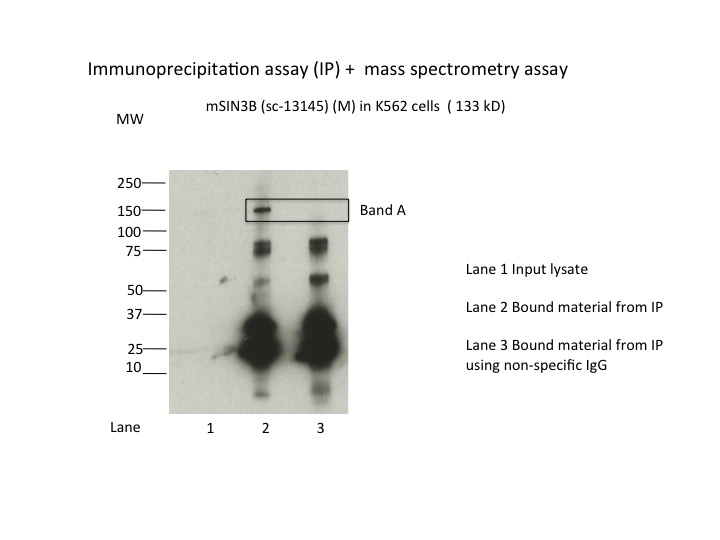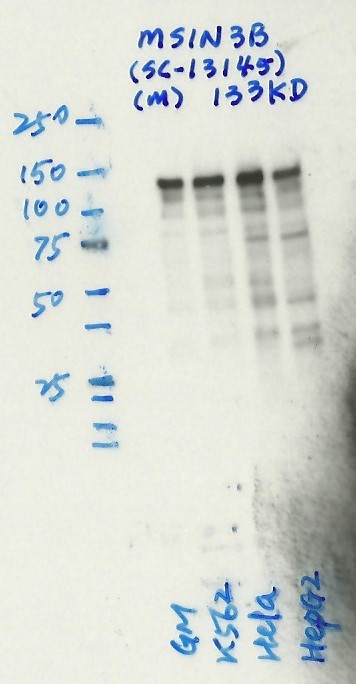ENCAB194LUB
Alternate accession: ENCAB081CER
Antibody against Homo sapiens SIN3B
Homo sapiens
GM12878, K562, HeLa-S3, HepG2
characterized to standards
- Status
- released
- Source (vendor)
- Santa Cruz Biotech
- Product ID
- sc-13145
- Lot ID
- B2802
- Characterized targets
- SIN3B (Homo sapiens)
- Host
- mouse
- Clonality
- monoclonal
- Isotype
- IgG2b
- Antigen description
- raised against amino acids 172-228 of mSin3B of mouse origin
- Aliases
- michael-snyder:SIN3B-human_sc-13145_B2802, michael-snyder:AS-1129
- External resources
Characterizations
SIN3B (Homo sapiens)
K562
compliant
- Caption
- Immunoprecipitation of SIN3B from K562 cells using sc-13145. Lane 1: input nuclear lysate. Lane 2: material immunoprecipitated with sc-13145. Lane 3: material immunoprecipitated using control IgG. Band A was excised from gel and subject to analysis by mass spectrometry. The expected band size is 133 kDa.
- Submitted by
- Kathrina Onate
- Lab
- Michael Snyder, Stanford
- Grant
- U54HG006996
- Download
- 1004_SIN3B_sc-13145.jpg
SIN3B (Homo sapiens)
GM12878K562HeLa-S3HepG2
compliant
- Caption
- Western blot analysis of nuclear lysates prepared from multiple cells lines loaded in the order: GM12878, K562, HeLaS3, HepG2 using the antibody sc-13145x. Molecular Weight: 133.066
- Submitted by
- Nathaniel Watson
- Lab
- Michael Snyder, Stanford
- Grant
- U54HG006996
- Download
- MSIN3B-WB-192.jpg
SIN3B (Homo sapiens)
Method: immunoprecipitation followed by mass spectrometry
compliant
- Caption
- IP followed by mass spectrometry: Briefly, protein was immunoprecipitated from K562 nuclear cell lysates using sc-13145, and the IP fraction was loaded on a 10% polyacrylamide gel (NuPAGE Bis-Tris Gel) and separated with an Invitrogen NuPAGE electrophoresis system. The gel was stained by Colloidial Coomassie G-250 stain, gel fragments corresponding to the bands indicated were excised. Then proteins were trypsinized using the in-gel digestion method. Digested proteins were analyzed on an Orbitrap Elite mass spectrometer (Thermo Scientific) by the nanoLC-ESI-MS/MS technique. Peptides were identified by the SEQUEST algorithm and filtered with a high confidence threshold (Peptide false discovery rate < 1%, 2 unique peptides per protein minimum, mass error < 10 ppm).
- Submitted by
- Kathrina Onate
- Lab
- Michael Snyder, Stanford
- Grant
- U54HG006996

